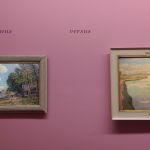Beyond the museum’s impressive graphic art collection, the Albertina truly guides its guest through the ages of art. The permanent collection guides the viewer from Monet to Picasso. Until January 8, the museum also focuses on pointillism. More specifically, the section focuses on how impressionism led to that art movement and how it affected Fauvism, which came after.
Finally, until March 19th, the museum also takes the guest to the contemporary art era. While unexpected, I thoroughly enjoyed the contemporary art section because you could clearly see meaning behind the subjects and arrangements. The Albertina does a fabulous job at displaying the most meaningful and accomplished paintings of a given movement. Below I have highlighted a couple paintings, done primarily by native German-speaking speaking artists. While the museum showcases artists such as Monet and Chagall, those works can be viewed at various museums and I wanted to highlight the uniqueness of this one.
Additionally, the Albertina is home of the Habsburg Staterooms. The most notable couple to have lived in this wing of the Hofburg is Archduke Charles and Princess Henrietta of Nassau-Weilburg. Explore the gallery to learn more!
Hint: When in Gallery mode, clicking on the picture toggles between showing and hiding the caption.
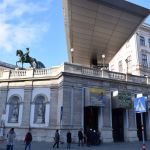
Prince Albert of Saxony married Maria Christina, with the special approval of Maria Theresia, in 1766. Due to this marriage, he moved in with the Habsburgs in Vienna from Brussels, where he had acted as the governor of the Habsburg Netherlands. He founded the Albertina in 1805 when he brought over his large collection of graphics from Brussels and lived there with his wife. They had no children and adopted Archduke Charles, whose parents, Holy Roman Emperor Leopold II and Mother Maria Luisa of Spain, died in 1792. Archduke Charles married Princess Henrietta of Nassau-Weilburg and they lived in the Albertina.
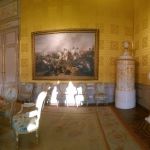
Reception Salon
Museum description: The couple was pronouncedly Francophile. The reception salon is therefore oriented to the style of the French Empire. On the other hand, the intense yellow of the silk wallpaper corresponds to the taste of the Viennese Biedermeier. The large mirrors are older. They originate from the Royal Palace of Laeken, the residence palace in Brussles of Charles’s adoptive parents, they were incorporated with an appreciation for their value.
The large format painting in the middle of the reception salon shows Field Marshal Archduke Charles with his general staff following the victorious Battle of Aspern near Vienna (20/21 May 1809). The victory over the French represented a decisive turning point in European history. Napoleon, who had to that point been considered invincible, was beaten on the battlefield for the first time.
Note: The room looks curved in the picture because it's a panorama.
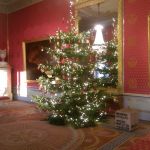
Museum description: Princess Henrietta was the wife of Archduke Charles. She was 26 years younger than Charles. Far more unusual than the age difference was the fact that Henrietta wasn’t a Catholic, but instead a Calvinist. Up to that time there had never before been a marriage between a Catholic archduke and a Protestant princess in the House of Habsburg! Because of Henrietta, the Protestant tradition of having a Christmas tree spread throughout the Habsburg territories. Upon Henrietta’s death, her brother-in-law Emperor Francis I said, "She dwelt among us when she was alive, and so she shall in death,” allowing her to be the only non-Catholic to be buried in the Imperial Crypt.
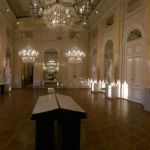
Apollo and the Nine Muses
Museum description:The larger than life sandstone figures represent the most expensive sculpture ensemble of Viennese Classicism. It originated from 1822-1825 as a commission of Archduke Charles with the Academy professor Joseph Klieber. The sculpture program makes direct reference to the usage of the hall as a dining room of the archducal family. In Greek mythology, the nine muses, led by their half-brother Apollo, accompany the dining of the gods with music and song. The nine muses are daughters of the father of the gods, Zeus and the Titan Mnemosyne, the goddess of memory. They inhabit Mont Parnassus, a famous mountain massif in Greece.
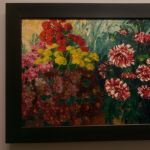
Garden with Autumn Flowers by Emil Nolde (1934)
My impression: What drew me to this painting is the way that color was used to make specific subjects stand out. The majority of the painting is in dull colors. It’s logical then that adding a bit of bright colors will make that specific section stand out. Nolde made the flowers on the right stand out by adding bright white. He could have made the flowers as dull as the other ones by adding a bit of black to the white to make it more gray-looking. By using the bright white, I get the feeling that the flowers are calling out, yelling “Look at me! Look at me!”
Museum description: In 1933, the National Socialists imposed an exhibition ban on Nolde. He retired to Seebüll, a small village in the north of Schleswig-Holstein close to the Danish border. He continued working there in complete seclusion.
During a long illness in the late summer of 1934, Nolde produced this large flower painting, showing red dahlias and other autumn flowers. The motif depicts the colorful diversity of blossoms in his garden at Seebüll. Today the artist’s refuge of those days houses the Emil Nolde Museum. Nolde’s means of composition are typical of the “Brücke” (Bridge) artists’ Expressionist style; simplified, partly unrecognizable forms and unrealistic, loud colors. The colors do not follow nature’s example any longer but turn into mere means of expressing emotions.
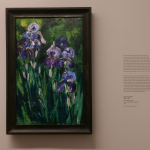
Irises in the Evening Shadows by Max Pechstein (1925)
My impression: Being a really big fan of impressionists, it’s no wonder that I was drawn to this picture. While it looks like a simple image of a couple flowers, what I love about this painting (and the impressionist style in general) is the way that they use color. Upon closer inspection, you can always see colors mixed in that you would have never guessed would make sense. In one petal, I can see more than five different colors mixed in. While Pechstein is not an impressionist, you can definitely see the movement’s influence in his painting.
Museum description: This flower painting was probably executed in Berlin, where Pechstein lived and worked from 1908 onwards. In those years, her strove for public recognition and an improvement of his financial situation. In 1923, he left the radical ‘November Group’ for the more moderate Berlin Secession. The painting illustrates how by the early 1920s the wild “Brücke” painter had almost metamorphosed into a conventional Secessionist. Both the composition and the colors indeed recall the style of Impressionism and show similarities not only to Nolde’s own flower pictures from the same period, but also to the iris pictures from the late period of Monet, who the latter had painted in his garden at Giverny during World War I.
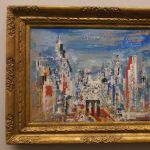
New York: East River by Wilhelm Thöny (1936)
My impression: This picture caught my attention because even through all of the distortion, the author is clearly depicting his subject. I could tell from first glance that that was a painting of New York even though I had only visited the city three times in my life.
Museum description: The Graz-born artist Wilhelm Thöny was one of the most outstanding artists of the first half of the 20th century. When more than 1,000 of his pictures stored in a warehouse in New York were destroyed by fire, this meant the loss of almost his entire life’s work. Thöny became famous for his views of Paris and New York, the metropolises of the modern world. He visited New York for the first time in 1933. Impressed by its gigantic skyline, he painted numerous works inspired by it when still in Paris, before he finally emigrated to the United States in 1938. This painting, a homage to the city in blue, white and red, the colors of the American flag, shows how much New York fascinated him. One can recognize such concrete motifs as the Empire State Building and Brooklyn Bridge, which are nevertheless defamiliarized through abstract details and expressive colors.
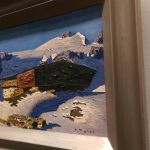
Solitary Mount in Farm by Alfons Walde (1933/34)
My impression: What caught me about this painting is the texture of it. Walde paints the scenery with such realistic shadows that you have the feeling that you are actually present in the picture. The texture of the painting plays to our sense of touch. Because of the texture, I imagine myself running my hands along the wood grain or on the rocks. I took the photo from the side not only to emphasize the texture but also to show that the painting moves with the viewer, as if they were walking around in the scenery.
Facts: Alfons Walde was an Austrian artist and architect, born in Tirol in 1891. He died in Kitzbühel in 1958.
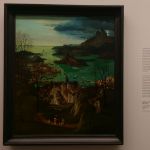
The Big Port by Herbert von Reyl-Hanisch (1928)
My impression: Von Reyl-Hanisch is an Austrian artist who moved around quite a bit as a child because his father was an officer in the army. At the outbreak of the First World War, he joined the army. While he was discharged due to a lung condition, by the time that he attended the Academy of Fine Arts in Vienna in his early twenties, the artist had already seen his fair share of death and despair. The artist’s background is displayed in this painting very clearly. While on the surface it looks very idyllic, the dark colors throughout and the storm in the background suggest something else. My favorite part of this painting is the way the artist used color to show the downpour in the background.
Museum description: The New Objectivity (Neue Sachlichkeit) movement also saw a return to nature, order, and the genre. The artist Herbert von Reyl-Hanisch was concerned with translating human emotions into so-called “landscapes of the soul.” The viewer of this picture looks down on an apparently medieval city from an elevation. It is no existing city though, but rather an ideal picture composed as a toy landscape. A wide path leads down to the city center, which is dominated by a twin-towered church. An industrial port with large warehouses and factories is to be seen on the left, while a modern residential neighborhood extends to the right. The harbor is full of hustle and bustle, ships and boats crowd the water, even a seaplane is part of the scene. A rugged rock landscape with islands and a lighthouse juts up off the coast. A dazzling flash of lightning breaks from dark storm clouds.
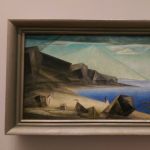
The High Shore by Lyonel Feininger (1923)
My impression: I like this painting because of its simplicity. Everything is very clearly defined and yet, it can be anywhere. The painting allows the viewer to guess and imagine the world that the three simply drawn people live in. The viewer can even decide for himself whether or not those people are actually there or a simple memory. While I typically do not like Cubism paintings, this painting has a certain mathematical harmony that I never get from Picasso’s paintings.
Museum description: Feininger had been teaching at the Weimar Bauhaus for four years when he committed these Cubo-Futurist memories of a holiday spent in a bay at the Baltic Sea near Lübeck to canvas. Whereas after Itten’s departure and his replacement by Moholy-Nagy, the Bauhaus was increasingly heading in the direction of design, technology, and a productive economy, Feininger continued to look for his motifs in Germany’s past culture and natural landscape. Due to their crystalline forms and natural colors, the beach huts and houses along the coast resemble rock formations and thus seem to have been restored to a natural state. On the other hand, such natural elements as water, the sky, and sand appear in the geometric guise of Bauhaus design.
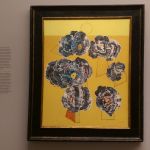
Flowers on a Yellow Ground by Max Ernst (1929)
My impression: While not a very appealing painting to me, I do recognize the creativity needed for the creation of this painting. The subjects of this painting, the flowers, were created through frottage against a wood board. It’s very interesting that the artist was capable of seeing and imagining flowers coming out of the wood-texture. Adding texture to the yellow background also gives the impression that the flowers are in fact real and resting on the table created as a background. Max Ernst was clearly a very inventive man as you will learn from the short blurb below.
Museum description: Max Ernst was a great experimenter who left an unmistakable imprint on the pictorial world of Surrealism with such new techniques as frottage, decalcomania, and grattage. For the latter method, the paint is thickly applied. In a subsequent step of scratching and rubbing accidentally created patterns, the forms undergo a process of metamorphosis and may come out as woods, birds, towns, and flowers. Between 1927 and 1929, Max Ernst worked on a series of charming and highly decorative pictures whose central motif id the shell- or snow-flower. The forms, which appear against a monochrome backdrop, are not brushed, but applied with a palette knife in such a way that the various layers of color overlap without blending, which results in a mysteriously sparkling brightness and shimmer. The light-colored, delicate palette of these pictures turned the page to a new, albeit short, chapter in Max Ernst’s career.
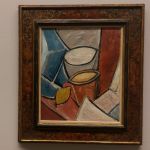
Pots and Lemon by Pablo Picasso (1907)
My impression: While Picasso is not of German-speaking origin, I wanted to include him in this selection because it shows the creation of new art movements. Reacting and replying to previous art movements requires a lot of studies and reflection. This painting, as explained below, shows the transition of a single painter’s art style ad well as the slow creation of a new art movement.
Museum’s description: For Picasso, the years 1906-1908 meant a phase of transition. He explored Black African and Oceanian art and extensively studied the works of Cézanne. His preoccupation culminated in the painting Les Demoiselles d’Avignon from 1907, which can be considered the starting point of Cubism. The preliminary works occupied him several months and comprised of more than 800 studies, including the present still life or, rather, the compositional design for the masterpiece that is hidden underneath the paint layers. X-ray photography has revealed a group of women of which only the buttocks and thighs of a crouching figure viewed from behind shine through the still life at the upper right corner. In its radical reduction of concrete objects to plain geometric forms, the still life itself is also based on the new archaic style developed for the Demoiselles and is an early example of Picasso’s Analytic Cubism.
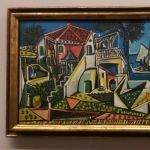
Mediterranean Landscape by Pablo Picasso (1952)
My impression: Again, I chose to show a painting by Picasso but for an entirely different reason. This painting shows that life is always reflected in what we do. Even though this painting looks perfect and serene with all of the clean, sunset colors, just like with Herbert von Reyl-Hanisch’s The Big Port, we should not be fooled by the first impression. Upon closer consideration, you can see the angular lines and the thick black color mixed in with all the reds and bright yellows. The museum description explains why the author might have felt this angst while painting this work.
Museum description: This picture shows the villa La Galloise in Vallauris in Southern France, into which Picasso moved in 1948 with his partner, Françoise Gilot. Paloma, their daughter, was born there in 1949. Although the painting seems idyllic at first sight, the congested composition and the angular, vigorously aggressive linear fabric reflect the unbearable tensions between Picasso and Françoise Gilot, which eventually led to their separation in 1953. The reduction of special depth, the interlaced architecture, and the walled garden suggest narrowness and oppression, whereas the sea and the sailing boat express the artists wish for change and a new start in life.
